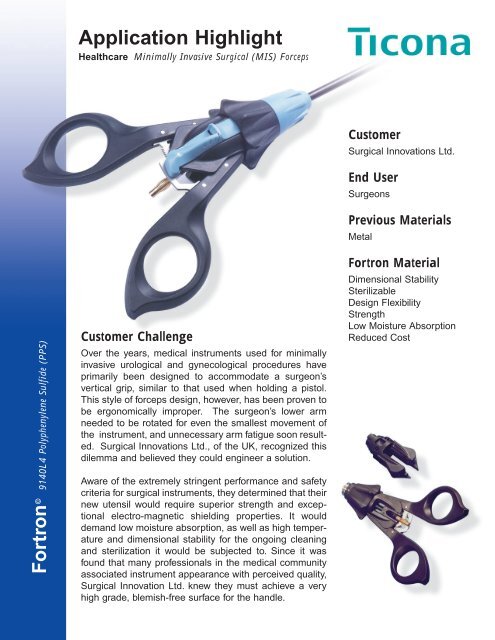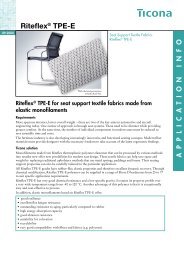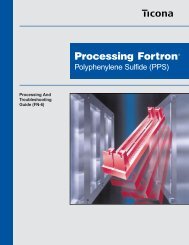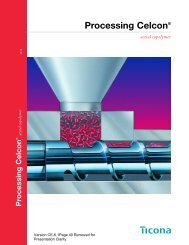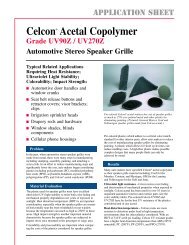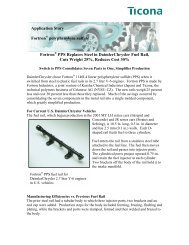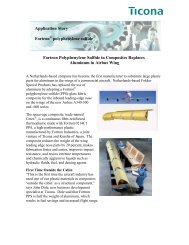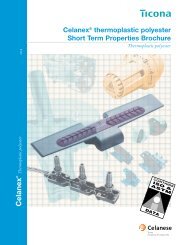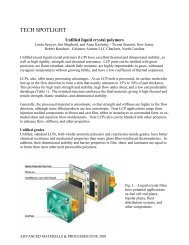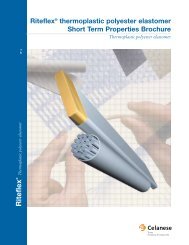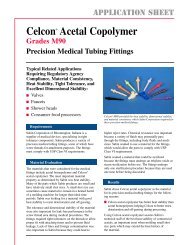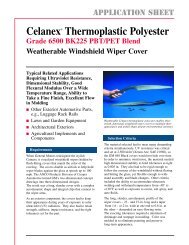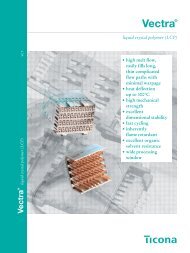Fortron PPS Medical Forceps - Hi Polymers
Fortron PPS Medical Forceps - Hi Polymers
Fortron PPS Medical Forceps - Hi Polymers
You also want an ePaper? Increase the reach of your titles
YUMPU automatically turns print PDFs into web optimized ePapers that Google loves.
Application <strong>Hi</strong>ghlight<br />
Healthcare Minimally Invasive Surgical (MIS) <strong>Forceps</strong><br />
Customer<br />
Surgical Innovations Ltd.<br />
End User<br />
Surgeons<br />
Previous Materials<br />
Metal<br />
©<br />
<strong>Fortron</strong> 9140L4 Polyphenylene Sulfide (<strong>PPS</strong>)<br />
Customer Challenge<br />
Over the years, medical instruments used for minimally<br />
invasive urological and gynecological procedures have<br />
primarily been designed to accommodate a surgeon’s<br />
vertical grip, similar to that used when holding a pistol.<br />
This style of forceps design, however, has been proven to<br />
be ergonomically improper. The surgeon’s lower arm<br />
needed to be rotated for even the smallest movement of<br />
the instrument, and unnecessary arm fatigue soon resulted.<br />
Surgical Innovations Ltd., of the UK, recognized this<br />
dilemma and believed they could engineer a solution.<br />
Aware of the extremely stringent performance and safety<br />
criteria for surgical instruments, they determined that their<br />
new utensil would require superior strength and exceptional<br />
electro-magnetic shielding properties. It would<br />
demand low moisture absorption, as well as high temperature<br />
and dimensional stability for the ongoing cleaning<br />
and sterilization it would be subjected to. Since it was<br />
found that many professionals in the medical community<br />
associated instrument appearance with perceived quality,<br />
Surgical Innovation Ltd. knew they must achieve a very<br />
high grade, blemish-free surface for the handle.<br />
<strong>Fortron</strong> Material<br />
Dimensional Stability<br />
Sterilizable<br />
Design Flexibility<br />
Strength<br />
Low Moisture Absorption<br />
Reduced Cost
Product Profile<br />
9140L4 Polyphenylene<br />
Sulfide (<strong>PPS</strong>)<br />
• high strength and modulus<br />
• withstands sterilization<br />
• dimensionally stable with<br />
low moisture absorption<br />
• complies with USP class VI<br />
and ISO 10993<br />
Ticona<br />
90 Morris Avenue<br />
Summit, NJ 07901<br />
www.ticona.com<br />
00-308/2M/0700<br />
©2000 Ticona<br />
Innovation<br />
They soon developed a precision forceps instrument that could operate<br />
horizontally, rotated simply by the turn of the surgeon’s wrist. The<br />
predominant feature of the ergonomic handle was a component that<br />
served as a node or pivot, providing the connection to all other parts.<br />
The design of the microsurgical utensil was modular to allow its central<br />
core to be fitted with a large number of operating tools, such as<br />
shears. An internal cone transmitted rotation and insulated against<br />
high voltage during electrocautery.<br />
To achieve the strength, stability and autoclavability needed in the<br />
complex handle of the new forceps, Surgical Innovations Ltd.<br />
explored a variety of options. Glass-filled nylon was examined but<br />
rejected due to its lack of sufficient dimensional stability during<br />
steam sterilization. The cost of polyethetherketone (PEEK) was<br />
found to exceed the production budget, and liquid crystal polymer<br />
(LCP) was not able to meet weld line strength demands and surface<br />
appearance requirements.<br />
Surgical Innovation Ltd. ultimately chose Ticona’s <strong>Fortron</strong><br />
polyphenylene sulfide (<strong>PPS</strong>) over nylon, PEEK, and LCP. The material<br />
selected was <strong>Fortron</strong> <strong>PPS</strong> 9140 L4, a 40% glass fiber reinforced<br />
linear <strong>PPS</strong>. The resin had high strength (tensile strength of 195 MPa<br />
and a flexural strength of 285 MPa), cost 90% less than PEEK, and<br />
had significantly less water absorption (0.02%) than nylon. It also<br />
had extraordinary dielectric and insulation properties, ideal for electrosurgical<br />
implements.<br />
Solution<br />
The lightweight, precision instrument, which is available in the U.S.<br />
and Europe, reduces surgeon fatigue and won two Awards for<br />
Excellence (in the medical and overall categories) at Interplas in 1999.<br />
The ergonomic handles contain eight molded components, which<br />
include a central core with stainless steel inserts and a cone that<br />
transmits rotation and insulates against high voltage during electrocautery.<br />
<strong>Fortron</strong>® 9140L4 Polyphenylene Sulfide Properties Relevant<br />
To This Application <strong>Hi</strong>ghlight<br />
Property Test Units Value<br />
Water Absorption ASTM D570 (wt)% 0.02<br />
Mold Shrinkage ASTM E831 mm/mm 0.002 - 0.006<br />
Tensile Strength ISO 527 MPa 195<br />
Flexural Strength ISO178 MPa 285<br />
Flexural Modulus ISO178 MPa 14,900<br />
Deformation Under Load @ 1.8 MPa ISO 75/A ˚C 270<br />
Coefficient of Thermal Expansion ISO 11359-2 10 -5 / ˚C 2.6 - 4.8<br />
Dielectric Strength ISO 60243 KV/mm 28<br />
<strong>Fortron</strong> 9140L4 Polyphenylene Sulfide (<strong>PPS</strong>)


